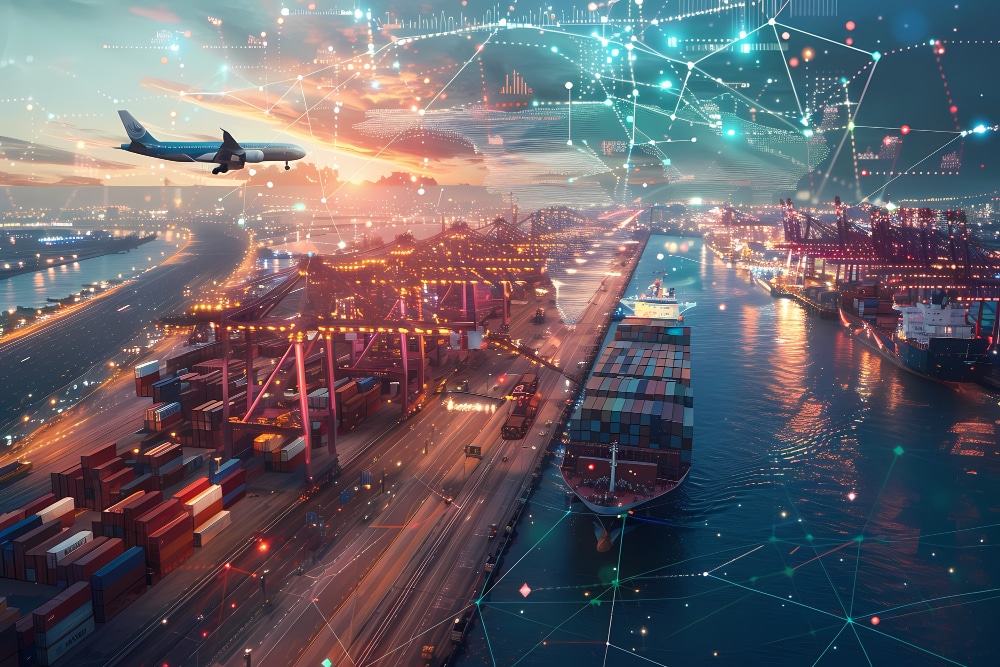In today’s interconnected world, understanding a company’s supply chain is crucial for anyone involved in business, from executives and investors to policy makers and even consumers. Supply chains are the lifeblood of global commerce, representing the journey products take from raw materials to the finished goods we buy. But how exactly can one map out these complex networks and find a company’s supply chain? At Permutable AI, we have been using advanced large language models (LLMs) to make this daunting task both efficient and insightful resulting in our Supply Chain Network Analysis Tool.
How to find a company’s supply chain: Why knowing a supply chain matters
Before diving into the how, let’s explore the why. Knowing a company’s supply chain isn’t just for logistics experts. It’s about gaining a comprehensive understanding of potential risks and opportunities. For businesses, it’s about ensuring continuity and resilience against disruptions like political instability or natural disasters. Investors can make more informed decisions, avoiding companies with vulnerable supply chains. Policymakers can better understand economic dependencies and vulnerabilities. Even consumers can appreciate the journey their products have taken, fostering more informed purchasing choices.
The complexity of supply chains
Supply chains are inherently complex – fact. They can span multiple countries and involve numerous suppliers, each with their own sub-suppliers. A disruption in one part of the world can ripple through the entire chain, causing delays, increasing costs, and even halting production. Traditionally, if you wanted to find a company’s supply chain and map out these intricate networks manually it would be like trying to navigate a maze blindfolded. This is where Permutable AI’s innovative approach comes into play.
How to find a company’s supply chain: How we do it
At Permutable AI, we use state-of-the-art technology, the same kind of AI technology behind groundbreaking tools like OpenAI’s GPT-4, to decode and map out supply chains. The above image showing Microsoft’s supply chain demonstrates this. Here’s a closer look at how we do this:
Data collection
The first step is gathering data. Permutable AI taps into an extensive repository of information, drawing from over 5,000 news sources, financial reports, government publications, and industry databases. They have the capacity to process up to 1 million articles per day, ensuring they capture the most up-to-date and relevant information.
Natural Language Processing (NLP)
Once the data is collected, it’s time to make sense of it. This is where NLP, a branch of AI that understands and interprets human language, comes into play. Our large language models sift through the data, identifying mentions of suppliers, products, locations, and transactions. The AI can recognize patterns and connections that would be nearly impossible for a human to detect, especially at such scale.
Entity recognition and relationship mapping
Our AI models are adept at entity recognition, identifying key players in the supply chain, from major manufacturers to smaller component suppliers. They then map out the relationships between these entities, creating a detailed picture of the supply chain. This process involves understanding not just direct suppliers, but also secondary and tertiary suppliers, providing a comprehensive view.
Real-Time updates
Supply chains are dynamic, with new links being forged and old ones dissolving regularly. Our system continuously monitors data sources for updates, ensuring the supply chain maps remain current. This real-time aspect is crucial for responding swiftly to disruptions and making proactive adjustments.
How to find a company’s supply chain: The benefits of using AI for supply chain mapping
So you want to find a company’s supply chain, but unsure about using AI to do this. So let’s discuss the benefits of using AI for supply chain mapping, which are manifold. Firstly, it drastically reduces the time and effort required compared to manual methods. What could take a team of analysts weeks or months can be accomplished in a fraction of the time with AI. Secondly, AI can process far more data than humans ever could, leading to more accurate and comprehensive maps.
Additionally, the use of AI in supply chain mapping opens up the possibility of predictive analysis. Our models don’t just map out the current state of a supply chain; they also have the potential to predict future disruptions and trends based on historical data and current events. This foresight is invaluable for strategic planning and risk management.
Real-world applications
Imagine a company that relies on electronic components for its products. By using our supply chain mapping, it can identify all the suppliers involved, right down to the providers of rare earth metals used in microchips. If geopolitical tensions threaten the supply of these metals, the company can quickly find alternative sources or adjust its production plans to mitigate impact.
For investors, understanding the supply chains of the companies they invest in can provide crucial insights into potential risks. If a company’s supply chain is overly dependent on a politically unstable region, it might be a red flag. Meanwhile, policymakers can use this information to understand the economic interdependencies between countries and industries, guiding decisions on trade policies and economic support.
How to find a company’s supply chain: Final thoughts
As global supply chains continue to grow in complexity, the need for innovative solutions becomes ever more critical. At Permutable AI, our use of large language models to map out these intricate networks represents a significant leap forward. By transforming vast amounts of data into actionable insights, they are helping businesses, investors, and policymakers navigate the complexities of the global economy with unprecedented clarity and precision.
In the fast-paced, ever-evolving world of supply chains, staying informed and prepared is key. With the power of AI, companies can not only understand their supply chains but also anticipate and mitigate risks, ensuring they remain resilient and competitive in the global market. At Permutable AI, our innovations are at the forefront of this revolution, making the invisible, visible. Want to find out more? Feel free to reach out to use at enquiries@permutable.ai to explore further.
